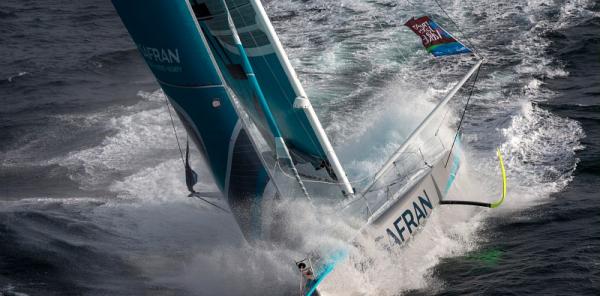
After having lived together in the Paul Vatine harbour in Le Havre for 10 days, the IMOCA 60s have already broken up. Faced with a very active Atlantic depression, the fleet has been split into two groups. The monohull Safran favoured the route to the west and is preparing to be hit, tonight, by a serious amount of wind and big seas. At the 1600hrs ranking (French time), Morgan Lagravière and Nicolas Lunven were 180 miles west of The Lizard (Cornwall, Britain) and lying in 9th place.
Changing conditions
Yesterday afternoon at the same time, the 42 competitors in the Transat Jacques Vabre were trying somehow to get out of the Bay of Seine in an erratic wind but under a bright sunshine. Twenty-four hours later, the atmosphere has changed: grey is the colour, the deck of the IMOCA 60 is continually being swept by waves, while a constant wind is pushing the monohulls to over 20 knots. It's challenging, wet and wild, but for now they are flying.
“We have 30 knots of wind at the moment and Safran is flying upwind at almost a constant 25 knots,” Morgan Lagravière said in the late morning. “After leaving the Bay of Seine, we're back in the game. We're happy with our position. We made some nice manoeuvres, we took regular turns on the helm and we made good sail choices. Physically it's tiring, but it's all working out as we want. Nicolas and I have immediately found our rhythm.”
The IMOCA fleet split into two groups this morning. Five competitors – who are provisionally the Class leaders – have chosen to head south-west to benefit from a trajectory close to the direct route, but which is upwind; while the monohull Safran and the rest of the fleet, favouring speed, decided to round the depression to the north. At the 1600hrs ranking, over the last two hours of racing, Safran was making 4 knots more than Alex Thomson and Guillermo Altadill's Hugo Boss.
“Unfortunately, the hard part is ahead,” Lagravière said of the first big test for the new monohull Safran. “We're a bit uncertain about what's coming and we're preparing as best as we can.”
By tonight, the wind will strengthen from the south to 30-35 knots, gusting to 45 knots and the sailors will face waves of 6 to 7 metres. Suffice to say, tough sailing conditions. For a few hours, the crews must preserve their mounts at the expense, perhaps, of the competition. But offshore racing is also an exercise in good seamanship. As to which of these two options will pay out, we will have to wait a few days to see.
























